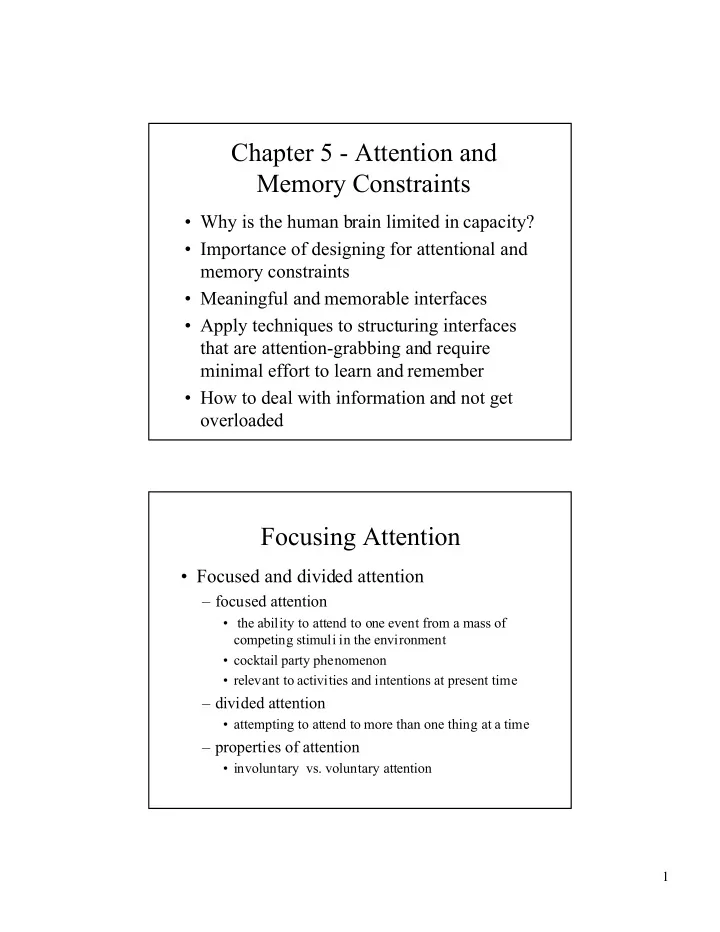

Chapter 5 - Attention and Memory Constraints ¥ Why is the human brain limited in capacity? ¥ Importance of designing for attentional and memory constraints ¥ Meaningful and memorable interfaces ¥ Apply techniques to structuring interfaces that are attention-grabbing and require minimal effort to learn and remember ¥ How to deal with information and not get overloaded Focusing Attention ¥ Focused and divided attention Ð focused attention ¥ the ability to attend to one event from a mass of competing stimuli in the environment ¥ cocktail party phenomenon ¥ relevant to activities and intentions at present time Ð divided attention ¥ attempting to attend to more than one thing at a time Ð properties of attention ¥ involuntary vs. voluntary attention 1
Relevance to HCI ¥ Structuring information Ð make it easy to navigate through and find information ¥ never too much information, never too little ¥ grouped and ordered in a meaningful manner Ð other techniques for guiding attention ¥ spatial and temporal cues ¥ color ¥ alerting techniques (flashing, audio) ¥ windows (partitioning) Guidelines for Designing Interfaces ¥ Important information displayed in prominent place to catch the userÕs eye ¥ Less important information is relegated to the background Ð specific areas, user should know where to look ¥ Information not often requested should not be on the screen, but should be accessible ¥ Attention and perception are intertwined 2
Multitasking and Interruptions ¥ Interruptions Ð moment to moment demands of the situation ¥ phone calls, doorbells, etc... ¥ Multitasking Ð carrying out a number of tasks during the same period of time by alternating between them Ð Primary vs. Secondary tasks ¥ primary task = most important task at that time Distraction ¥ People good at multitasking Ð prone to distraction ¥ repetition and automation ¥ Solution = cognitive aids Ð external representations that are intended to gain our attention at a time relevant to the task that needs to be performed ¥ Applications to HCI Ð system inform user where he was Ð remind user of common tasks 3
Automatic Processing ¥ Automated activities Ð activities done without thinking ¥ reading, writing, biking, etcÉ Ð characteristics of automated activities ¥ fast ¥ demanding minimal attention ¥ unavailable to consciousness Ð Stroop effect ¥ conflict between automatic skills Automatic Processes vs. Controlled Processes ¥ Automatic processes Ð not affected by limited capacity of brain Ð do not require attention Ð difficult to change once they have been learned ¥ Controlled Processes Ð non-automatic processes ¥ limited capacity ¥ require attention and conscious control 4
Memory Constraints ¥ Levels of Processing Theory Ð information can be processed at different levels, from shallow analysis to deep semantic analysis ¥ meaningfulness affects how well something can be remembered ¥ more deeply processed items are better remembered ¥ meaningful items are more deeply processed ¥ contributions to meaningfulness Ð familiarity - frequency at which word occurs in everyday language Ð imagery - ability to elicit images in oneÕs mind Meaningful Interfaces ¥ Remembered items at interface should be memorable / meaningful Ð what is meaningful? ¥ confusion with commonly used words ¥ Common errors in interfaces Ð arbitrary assignment of commands Ð abbreviations / combination of control keys ¥ Use contextual, cultural, user characteristics 5
Meaningful Icons ¥ Context Ð setting in which icons are used (shoe example) ¥ Function / Task Ð benefits of icons ¥ when recognition plays a major part in tasks ¥ when unsure of precise nature of information ¥ when there are a diversity of manipulative operations to be performed Ð drawbacks of icons ¥ retrieve text in textual form Meaningful Icons (cont.) ¥ Representation form Ð 3 forms of representation ¥ use of concrete objects ¥ use of abstract symbols (arrows, circles, dots) ¥ combination Ð Mapping used to represent underlying concept ¥ resemblance icons - depict underlying concept through analogous images (falling rock sign) ¥ exemplar icons - the typical example (bathroom) 6
Representation Form (cont.) ¥ symbolic icons - conveys underlying referent that is at a higher level of abstraction than the image itself (wine glass with crack) ¥ arbitrary icons - no relation to underlying concept and hence association has to be learned (elephant example) ¥ Meaningfulness related to underlying concept Ð concrete icons = easy to remember (files) Ð abstract icons = harder to remember (warning signs) Combinations and Animated Icons ¥ Combination of icons and commands Ð reduces icon confusion Ð takes up more space on screen ¥ Animation Ð dynamically conveys meaning of icon Ð must focus on key aspects of a function Ð small size of icons Ð can be distracting 7
Recognition vs. Recall ¥ Recognition Ð information from the world ¥ Recall Ð information stored in the head ¥ Recognizing material far easier than recalling from memory ¥ Cognitive mnemonics Ð aid to memory Knowledge in the World and User Interfaces ¥ Graphical interfaces reduces mental effort - interface does the remembering ¥ People use one another as knowledge resources ¥ Episodic memory Ð information that is retrieved by searching through memory (experts) ¥ Semantic memory Ð large body of general knowledge we build up throughout our lives 8
Recommend
More recommend